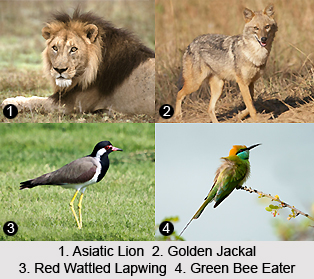Nauradehi Wildlife Sanctuary, established in 1975, is located across the districts of Narsinghpur, Damoh and Sagar, near the town of Jabalpur in Madhya Pradesh, India. It is one of the less explored regions and comprises of a range of unique wild animals and birds. The Nauradehi Wildlife Sanctuary has been selected for Cheetah re-introduction Project in India, which will improve the conservation efforts. The vast densely forested region consists of 2 vital river basins, Ganga and Narmada. Moreover the Yamuna basin also falls in part of the sanctuary. Nauradehi used to be a Tiger reserve, but lately no tigers are found here, although the authorities claim that tigers are still present. The protected areas of Nauradehi Wildlife Sanctuary houses immense transitional biodiversity. Various animals like Leopard, Nilgai, Indian Wolf, Sloth Bear, Hyena etc are found here. Moreover a huge variety of birds are also taking shelter in these lush green surroundings.
Geography of Nauradehi Wildlife Sanctuary
Nauradehi Wildlife Sanctuary is spread over an area 1187 sq km and is situated roughly in Centre of Madhya Pradesh. The area is well connected with Jabalpur, which is only 86 km away. The sanctuary can also be reached from Bhopal, around 210 km; Sagar, which is only 65 km from the region and almost 60 km from Damoh. The nearest railway stations are Damoh and Sagar stations, where as Jabalpur railway station is also close. Sagar and Jabalpur have the nearest aerodrome, where chartered flights arrive. Jabalpur Dumna Airport is another option for reaching Nauradehi. Rahli and Sagar are the nearest Bus stands.
 The sanctuary has an average elevation of 400-600 MSL and the average annual rainfall is around 1200 mm. in summer, which lasts from March to June, the temperature varies from 30 degree Celsius to 48 degree Celsius. Where as, in winter, from November to February, the temperature lies between 5 degree Celsius and 30 degree Celsius. The densely forested area is scattered over the Vindhyan hills, where Panna and Bandhavgarh national parks are located. The Vyarma and Bamner River drains the sanctuary providing adequate water to the wildlife. The topography is encompassed with mounting hills, low valleys scattered with lakes and rivulets.
The sanctuary has an average elevation of 400-600 MSL and the average annual rainfall is around 1200 mm. in summer, which lasts from March to June, the temperature varies from 30 degree Celsius to 48 degree Celsius. Where as, in winter, from November to February, the temperature lies between 5 degree Celsius and 30 degree Celsius. The densely forested area is scattered over the Vindhyan hills, where Panna and Bandhavgarh national parks are located. The Vyarma and Bamner River drains the sanctuary providing adequate water to the wildlife. The topography is encompassed with mounting hills, low valleys scattered with lakes and rivulets.
Flora and Fauna of Nauradehi Wildlife Sanctuary
Nauradehi Wildlife Sanctuary is rich with lush green vegetation, small grasslands and dense tropical dry and mixed deciduous forests, pregnant with Saaj. Floral variety comprises of Dhaora, Teak, Bhirra, Ber and Amla. Teak dominates the forested region. Amongst the animals found here, the most noteworthy are, Leopards, Tiger, Asiatic Lions, Indian Wolf, Sloth Bear, Chinkara, Nilgai, Sambar, Barking Deer, Black Buck, Spotted Deer, Rehsus Macaque, Langur, Wild Boar, Striped Hyenas, Golden Jackals, Mongoose, Wild Dogs, Jackal, Grey Fox, Monitor Lizard, Otter, Fresh Water Crocodiles, Turtles and Tortoises and various species of Snakes. The Indian Wolf is endangered and rare and thus steps are taken for its conservation.
Nauradehi Wildlife Sanctuary is a great prospect for bird watching as numerous species of migratory and resident birds take shelter in the forest and water bodies. A number of birds are found in the sanctuary, like Sarus Crane, Lesser Whistling Teals, Spotted Grey Creeper, Painted Stork, Orioles, Lesser Adjutant Stork, Grey Heron, Peacock, Minivet, Parakeet, Eagle, Stork Billed Kingfisher, Quail, Partridge, Open Billed Stork, Spotted Owl, Dove, Vulture, Egret, Kite, Red Wattler Lapwing, Barred Jungle Owlet, Pond Heron, Black Shouldered Kite, Green Sandpiper, Wood Sandpiper, Pied Myna, White Throated Kingfisher, Yellow Wagtail, Black Drango, Purple Sunbird, Indian Robin, Jungle Babbler, Long Tailed Shrike, Rock Pigeon, White Rumped Vulture, Black Ibis, Egyptial Vulture, Indian Roller, Golden Oriole, Magpie, Grey Francolin, Paddy Field Pipit, Common Indian Myna, Green Bee Eater, Common Jungle Crow, Greater Coucal, Crested Serpent Eagle and others.
Wildlife Tours in Nauradehi Wildlife Sanctuary
Nauradehi Wildlife Sanctuary has huge potential wildlife tours and bird watching. Tourism in the area is barely regulated by the authorities and only a few travelers visit the sanctuary as it is lesser known amongst tourists. The region could be developed manifold to project it as one of the leading eco-tourism destinations, as various national forests and tiger reserves like Bandhavgarh, Rani Durgawati, Pench and Kanha are located nearby. The infrastructure includes rugged roads that criss-cross through the jungle, along with rest houses and watch towers. Jeeps are available for wildlife safari.
There are other tourist places in the neighbouring areas, namely, Eran, Rangir, Gauridant Hillock, Rahatgarh and Tikitoria. Dan Baba and Hulki Mai are the nearby pilgrim and religious tourist locations. The best season to visit Nauradehi Wildlife Sanctuary is from November to March. By the implementation of proper conservation measures, tourism in the region can be developed and more visitors can be attracted.



















